Removing and recycling platforms

It began with the topsides on the Ekofisk tank. That job lasted until May 2007, and was then followed one after the other by the steel Ekofisk I platforms which were to be taken away.
Recycling yard
In Norway, an industrial site at Nedre Vats in Vindafjord local authority north of Stavanger began the breaker’s yard and recycling facility for these redundant facilities. Petroleum and energy minister Torhild Widvey performed the official opening of this AF Decom yard on 18 August 2005. It lay in the same place where Norwegian Contractors had mated its Condeep concrete platforms.
Et enstemmig kommunestyre i Vindafjord hadde til tross for protester fra beboere og bedrifter, miljøorganisasjoner og fylkeskommunen mot støy, giftutslipp i sjøen og rasering av kulturminner, godkjente reguleringsplanen. A unanimous local council had approved the new use of the site – despite protests from residents and companies, environmental organisations and the county council over noise, toxic discharges to the sea and destruction of cultural relics.
According to chair Arne Bergsvåg from the farmer-oriented Centre Party, the council was also against toxic discharges to the fjord. But he believed that frequent inspections and tougher requirements on discharge volumes would ensure that the business was carried on in an acceptable manner. “However, we can naturally never safeguard ourselves 100 per cent,” he admitted. A strong argument for the council was that the yard would employ about 150 people over a long period.[REMOVE]Fotnote: NTB, 19.12.2007, ”Vindafjord blir gravplass for oljeplattformer”.
Tank topsides first – 2005-08
Totalling some 26 000 tonnes, the steel superstructure on the Ekofisk tank led the way in the removal programme and 18 people from AF Decom made preparations there from the spring of 2005. This work was stepped up in September, with 40 of the company’s employees at work offshore. The first excavators equipped with hydraulic shears had arrived in June.
 historie, 2005 – 2013, fjerning og gjennvinning av ekofisk plattformer,
historie, 2005 – 2013, fjerning og gjennvinning av ekofisk plattformer,These machines “ate” their way through the superstructure, and sorted the remains roughly into containers. Such an operation had never previously been done offshore.
No less than 24 500 tonnes of shredded material, mostly steel, were loaded into supply vessels for shipment to the recycling yard at Vats.
The waste was then sorted and further processed and checked before being transported for smelting and possible deposition. The recycling ratio was no less than 98 per cent.[REMOVE]Fotnote: Pioner, nr. 3 2008.
Removal work on the tank was over by the end of 2007, with onshore disposition finished the following year. A total of 2 800 containers had then been sent ashore in 108 shipments. That left only the concrete structure of the tank with its “20-metre” deck and part of “30-metre” deck visible. An era in Norwegian oil history was over, and the Ekofisk seascape had been altered for ever.
Dismantling nine platforms
Dutch installation, heavy lift and subsea specialist Heerema Marine Contractors (HMC) had the main contract with AF Decom Offshore as organiser of the work before removal and deposition on land at Vats. This job covered the removal of nine Ekofisk I platforms, with an option for another four. AF Decom had the main contract for removing the Ekofisk tank topsides.
The dismantling work carried out by HMC ran for five years from 2009 to 2014. It was worth NOK 1.2 billion, including options.[REMOVE]
Fotnote: NTB, 18.06.2008, “Milliardavtale om fjerning av plattformer”.
Platform removal on Edda in 2006
The first field to have its lighter structures removed as part of the cessation project was Edda, 13 kilometres south-west of Ekofisk, and involved the flare stack, bridge and bridge support.
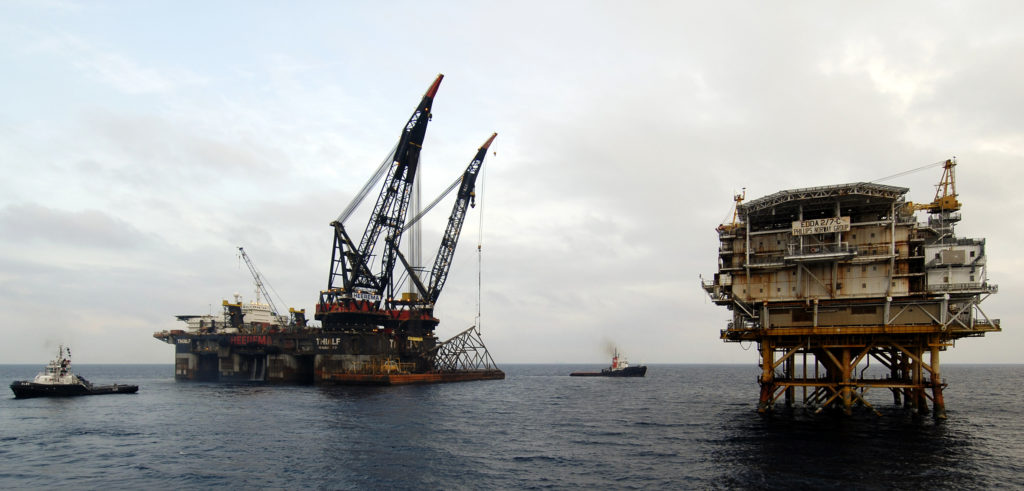 historie, 2005 – 2013, fjerning og gjennvinning av ekofisk plattformer,
historie, 2005 – 2013, fjerning og gjennvinning av ekofisk plattformer,HMC used Thialf – one of the world’s largest crane vessels – for this operation. Its work deck alone is bigger than two football pitches.
With more than 260 personnel on board, it resembles a large, well-organised anthill with people working everywhere between containers and heavy lifting gear. The heaviest Edda lift was 750 tonnes, which could almost be considered a fleabite for Thialf with its crane capacity of no less than 14 000 tonnes.
“It’s important for us to harvest experience now,” explained Dag Roar Johansen, ConocoPhillips’ project manager. “This operation has been very successful.”[REMOVE]Fotnote: NTB, 26.06.2009, “Skal fjerne Norges første plattformer”.
Each lift called for unique plans and special adjustments to ensure that it was carried out safely and in an environment-friendly manner.
Removing the bridge support presented a particular challenge on Edda. A cutting tool utilising sand and water under high pressure was lowered inside the structure. This allowed its piles to be cut 2.5 metres below the seabed so no obstacles to future maritime activities were left. The operation was viewed with some trepidation because it demanded good weather and free access for the cutting equipment to the necessary depth between the seabed.
Another critical operation involved lifting the support and turning it through 90 degrees in order to place it horizontally on a barge. A work platform was installed on top, with new pad eyes welded on for attaching steel ropes. Fixing one of these low down on one leg presented particular difficulties. This was done while the support hung from the crane. When the pad eyes was ready, strong ropes were used to attach it to the other crane.
The operation was completed with both cranes lifting in tandem, turning the support and placing it on the barge. Once all the structures were attached to its deck, this vessel could sail for Vats.[REMOVE]Fotnote: Pioner, “Lette strukturer fjernes”, ConocoPhillips, August 2006.
Removing light structures in 2007
Four removal projects were pursued with light structures in the GEA during the summer of 2007, starting in June with the removal of flare stack, bridge and bridge supports from Albuskjell 1/6 A. This job utilised the Hermod crane vessel, which had a lifting capacity of 8 100 tonnes and more than 250 people working on board.
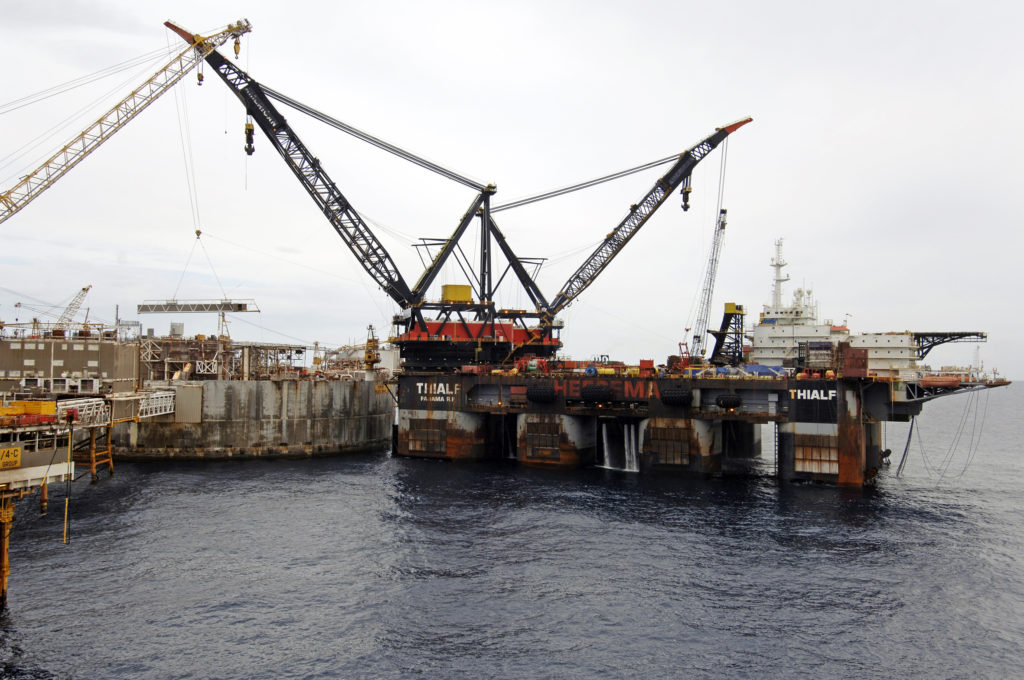 historie, 2005 – 2013, fjerning og gjennvinning av ekofisk plattformer,
historie, 2005 – 2013, fjerning og gjennvinning av ekofisk plattformer,The next job was at the Ekofisk Complex, where the northern flare stack with associated bridge supports and bridges on the north side of Ekofisk 2/4 R were removed.
Finally came the light structures on the Cod 7/11 A platform. All the steel from these removal operations was transported by barge to AF Decom’s yard at Vats.[REMOVE]Fotnote: Pioner, no 5, “Fjerning av lette strukturer”, ConocoPhillips, June 2007.
Pipeline pumping stations removed, 2009-10
In the 2009 summer season, the giant crane on Thialf had the job of lifting away redundant installations and bridges which isolated the Ekofisk tank from the rest of the Ekofisk Complex. The vessel was also involved in making safe on 2/4 W and removing sections from this platform after a ship had collided with it in June of the same year. During September, fellow HMC crane vessel Hermod completed the job of removing the topsides from the two pumping platforms in the UK North Sea.
The 37/4 A and 36/22 A structures stood along the oil pipeline which ran from Ekofisk to Teesside in north-east England. Their topsides were taken ashore for recycling.[REMOVE]Fotnote: Pioner, no 6, “Fjerning fortsetter neste sommer”, ConocoPhillips, 2009.
Thialf, the bigger of the two ships, then arrived to remove the jackets for these two platforms. In both cases, it took the structures to a breaker’s yard at Mekjarvik outside Stavanger. They were split in two there, with the lower part transported on to the recycling facility at Vats by barge, while the crane ship carried the upper section to the same destination.[REMOVE]Fotnote: Pioner, no 4, “Sluttdisponering Ekofisk I”,» ConocoPhillips, 2010.
Big tonnages shipped away in 2010-11
Crane vessels carried no less than 25 000 tonnes of platform components to Vats during May-August 2010, with Hermod discharging at the yard for the last time at the end of July. That final consignment included the remaining modules from Albuskjell 2/4 F and half the module support frame (MSF) for that platform. This was one of the two installations which had stood on Albuskjell and had been on stream until 1990. Its jacket was removed the following year.
Hermod was in action on Edda 2/7 C and West Ekofisk 2/4 D to make them safe and prepare to remove their topsides and jackets in 2011 and 2012 respectively.
Thialf finished its 2010 work at the end of August, with a final lift carried out at the Ekofisk Complex with the jacket for the 2/4 R riser platform.
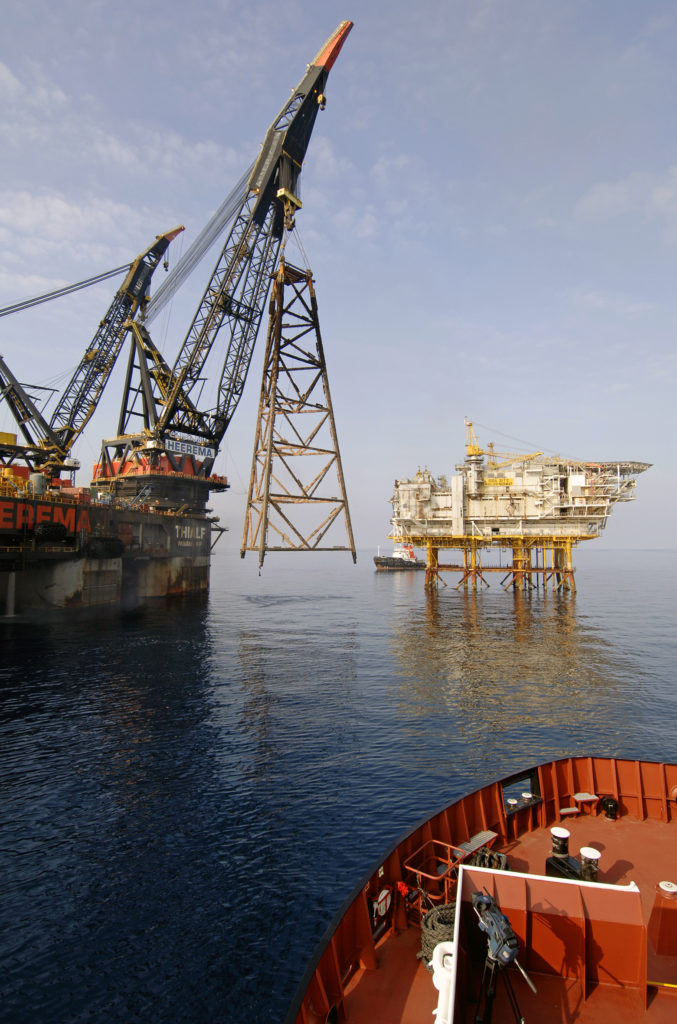 historie, 2005 – 2013, fjerning og gjennvinning av ekofisk plattformer,
historie, 2005 – 2013, fjerning og gjennvinning av ekofisk plattformer,The 2011 summer season began as early as mid-April, when Thialf left the Åmøy Fjord near Stavanger en route for Ekofisk. It remained in action until mid-August. During that period, it made six round trips between the GEA and Vats. The total amount removed amounted to roughly 25 000 tonnes – roughly the same as the year before.
The work programme began with making safe on Cod 7/11 A, followed by removal of the large and complex topsides from Edda 2/7 C. Thialf had to make two round trips to Vats with modules weighing a total of 11 000 tonnes.
Removing the topsides from West Ekofisk 2/4 D was the next assignment, before the vessel turned to Albuskjell 2/4 F to take away its jacket. Because of its size, the latter was divided horizontally into two sections before transport.
New heavy lifts in the summer of 2012
Thialf and fellow crane vessel Balder continued the GEA removal operation during the 2012 summer season, with Balder starting to prepare the Edda 2/7 D and West Ekofisk 2/4 D jackets in mid-June. After delivering half the MSF from Edda 2/7 D to Vats in July, this vessel began lifting off the Cod 7/11 A topsides. Seven modules had been removed by 31 July. Mobilised in July, Thialf started by lifting the remainder of the MSF on Edda 2/7 D and the top half of its jacket onto the deck. It then raised the bottom section and sailed for land with that structure hanging from its crane. Delivery was made to Vats by the end of the month. Thialf then returned to Edda 2/7 C in order to remove the jacket, and was back in Vats on 10 August to deliver the upper section of this structure. It finished by taking away the bottom part of the 2/7 C jacket.
Summer 2013 – lifting campaign completed
The lower part of the Albuskjell 1/6 A jacket had the honour of completing the lifting campaign for the summer season of 2013. That meant the last of nine agreed installations was gone.
Tialf mobilised at the end of August, and started with the Cod jacket before moving on to the 1/6 A structure. That was so large it had to be transported in two stages.
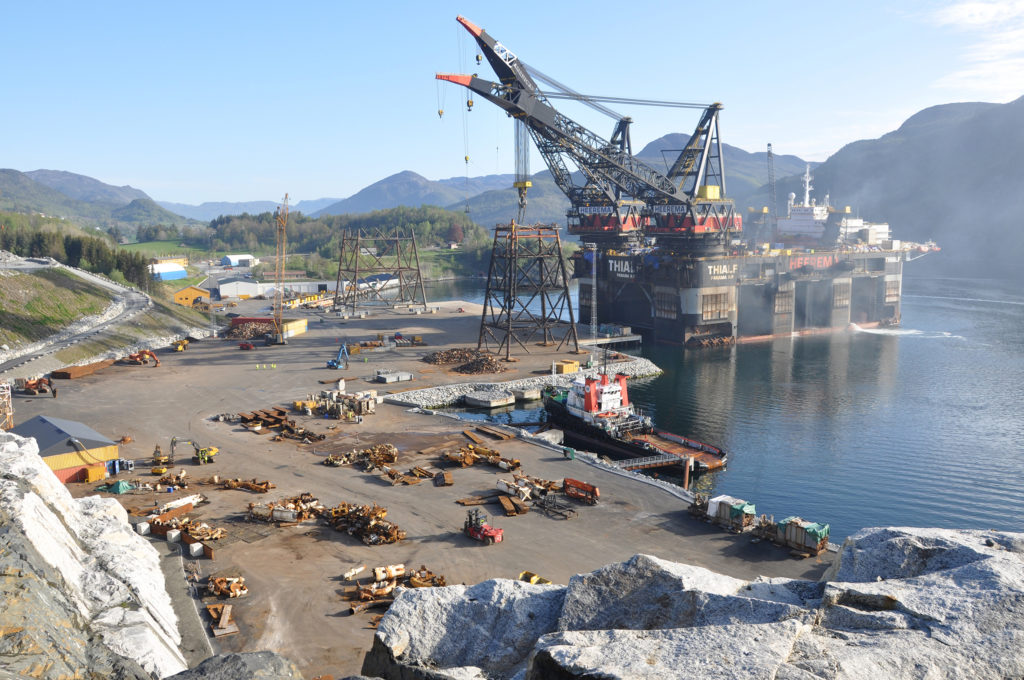 historie, 2005 – 2013, fjerning og gjennvinning av ekofisk plattformer,
historie, 2005 – 2013, fjerning og gjennvinning av ekofisk plattformer,The final delivery to Vats was on 22 September. Earlier that summer, the Albuskjell platform’s topside had been taken ashore. Some 25 000 tonnes were removed that year as well.
“With this year’s campaign, we’ve reached an important milestone for the company,” said Johansen. “We have then fulfilled our commitment to the government to remove these nine platforms [37/4 A, 36/22 A, 2/4 R, 2/4 P, 2/4 F, 2/4 D, 2/7 C, 7/11 A and 1/6 A] by the end of 2013.” Ekofisk I had really become history – and its individual components had been recycled for new applications.
Season eight – 2014
Two accommodation modules were removed by HMC from the 2/4 Q platform in the Ekofisk Complex during July 2014 and taken to Vats for scrapping.
When operational in 1974, this platform had been the first permanent accommodation platform in the Norwegian North Sea. It served for an impressive 30 years – admittedly with two extensive module replacements to meet new working environment requirements.
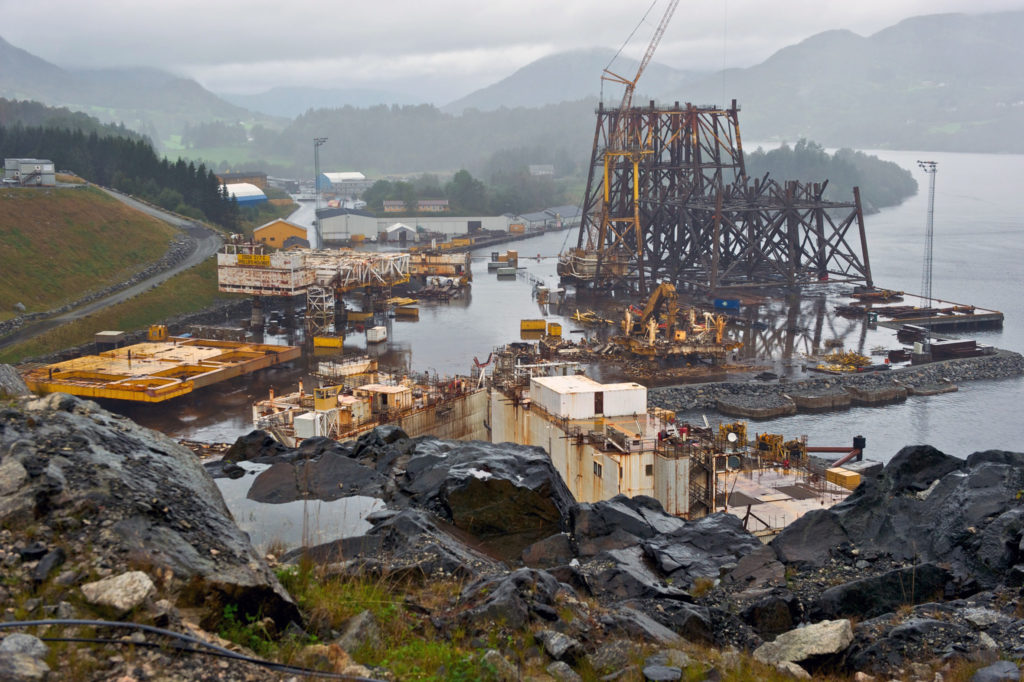 historie, 2005 – 2013, fjerning og gjennvinning av ekofisk plattformer,
historie, 2005 – 2013, fjerning og gjennvinning av ekofisk plattformer,The jacket for Ekofisk 2/4 S and the bridge support were also removed on the northern side of the complex. Statoil led this work on behalf of Gassco, which owned the structure, while ConocoPhillips provided technical backing.
The very last lift in this major campaign was the bridge linking the tank with Ekofisk 2/4 G, which had been shut down in 1998. ConocoPhillips again gave technical support to operator BP.
That year’s activities again went according to plan and with good safety results, Johansen reported in an interview with house journal Pioner. “Excellent collaboration with the operations organisation on land and offshore as well as good follow-up by our own team have been the key to such execution,” he said. In the course of eight years, 130 000 tonnes of steel had been removed from the GEA without serious threats to life or health – a unique operation.
Planning and implementing the removal of these platforms and pipelines was a technical and organisational achievement on a par with the big development projects off Norway.
But the story does not end there. The Ekofisk 2/4 A, 2/4 H, 2/4 Q and 2/4 FTP installations have later been removed between 2017 and 2021. The total number of installations removed from Ekofisk was 14 in 2022.
First oil company interested